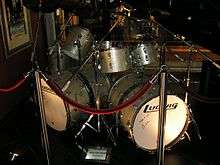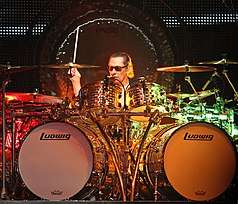Ludwig Drums
Ludwig Drums is a US musical instruments manufacturers, focused on percussion. The brand achieved significant popularity in the 1960s due to the endorsement of the Beatles drummer Ringo Starr.[2]
 | |
| Subsidiary | |
| Industry | Musical instruments |
| Founded | 1909 in Chicago [1] |
| Founder | William F. & Theobald Ludwig [1] |
| Headquarters | , |
Area served | Worldwide |
| Products | Drum kits and hardware, marimbas, vibraphones, xylophones, bar chimes |
| Parent | Conn-Selmer |
| Website | ludwig-drums.com |

Products manufactured by Ludwig include drum kits and hardware. The company also commercialises other percussion instruments (from the Musser Mallet Company acquired in 1965) such as marimbas, vibraphones, xylophones and bar chimes through its parent company Conn-Selmer.[3][4]
History
The Ludwig Drum Company was established in 1909 by William F. & Theobald Ludwig, sons of a German immigrant to the United States.[5] William Jr. had been a professional drummer, playing with circuses and touring vaudeville shows, along with the occasional skating-rink gig. Since this work was irregular, he and his brother, Theobald, opened a drum shop in Chicago; they called it Ludwig & Ludwig.[6] The company started with a concept for the design and manufacture of a functional bass drum pedal.[7]
The company added new products to its catalog, such as snare drums and timpani, in 1916. In 1917, Ludwig signed a deal to build rope drums to support World War I. Theobald Ludwig died in 1918, and William continued on his own.[7] By 1923, the factory was the largest drum manufacturer in the world, employing 240 workers.[6]
In the late 1920s, the company was sold to the C.G. Conn instrument company. William Ludwig stayed on to run the company for Conn (which also owned the Leedy Drum Co. at this time). Eventually, William Ludwig decided to leave Conn and start a new company of his own. He was unable to use the Ludwig name since that trademark now belonged to Conn who continued to market Ludwig & Ludwig drums.
%2C_American_Banjo_Museum.jpg)
_at_American_Banjo_Museum.jpg)
_at_American_Banjo_Museum.jpg)
In 1937, William bought a factory building and started The WFL Drum Company (his initials). The company continued producing drums at a small scale for the duration of World War II, but William got back to the idea of making the company a large drum manufacturer after the armistice. WFL was a competitor with Ludwig and Ludwig. Conn combined their two drum brands into one in the early 1950s, forming Leedy & Ludwig, and then decided to quit the drum business altogether. In 1955, William and his son Bill Jr. were able to buy the Ludwig trademark back from Conn, and over the next few years their company and its products transitioned from the WFL brand to being called "Ludwig" again.
William Ludwig's grandson[6]
Despite initial success, Ludwig's global breakthrough would occur February 9, 1964, when The Beatles made their historic American TV debut on The Ed Sullivan Show,[9][10] and the Ludwig logo, displayed on the front of Ringo Starr's bass drum, could be seen by the television audience of about seventy-three million people.[1][6][10] As it happens, Starr chose that brand upon joining the band simply because he liked the oyster pearl black color of the drum kit he chose. Regardless, the publicity resulted in Ludwig's sales doubling quickly to $13 million, which prompted production to increase to a 24/7 production as the company became the foremost drum manufacturer in North America for twenty years.[11]
Ludwig acquired the "Musser Mallet Company", a manufacturer of xylophones, marimbas and vibraphones, in 1965.[5] Ludwig was a strong presence in the marching drum market. Their drums along with their Slingerland rivals. During the 1970s, Ludwig's “Challenger” line of snare drums offered sophisticated tuning and strong build quality. Ludwig drums were used by many leading drum and bugle corp.
On 4 November 1981, William F Ludwig II sold the business to the Selmer Company (now Conn-Selmer). Selmer closed the Damen Avenue factory in the ensuing years and moved the drum production business to Monroe, North Carolina, in 1984.[5][6][12] In 2002, Ludwig merged with Conn-Selmer, becoming a brand of Conn-Selmer, Inc..[13]
The Musser manufacturing facility remained in LaGrange, Illinois, until 2013, and was then moved to Elkhart, Indiana.[14]
Artists
Some of the musicians that currently or previously played Ludwigs include:[15][16]
- Jerry Allison (Buddy Holly & The Crickets)
- Carmine Appice[17]
- Mick Avory (Kinks)
- Ginger Baker
- Derek Ballard (A Band Called O)
- Barriemore Barlow (Jethro Tull)
- Frank Beard (ZZ Top)
- Fred Below
- Pete Best
- Hal Blaine
- Jason Bonham
- John Bonham (Led Zeppelin)[18][19]
- Cindy Blackman (Lenny Kravitz)
- Don Brewer (Grand Funk Railroad)
- Bill Bruford (Yes, King Crimson, Genesis, Earthworks)[20]
- Tony Buck
- Clive Bunker (Jethro Tull)
- Larry Bunker (jazz and studio legend)
- Jim Capaldi (Traffic)
- Eric Carr (KISS)
- Nameless Ghoul (Ghost)
- Luis Cardenas (Renegade)
- Bun E. Carlos (Cheap Trick)
- Karen Carpenter
- Vinnie Colaiuta
- John Cowsill (Cowsills, Beach Boys)
- Mark Craney (Jethro Tull)
- Peter Criss (KISS)
- Dino Danelli (Young Rascals)
- John Densmore (The Doors)
- Michael Derosier (Heart)
- Bobby Elliott (The Hollies)
- Gregg Errico (Sly & The Family Stone)
- Rob Finch (Elemental Joe)
- Mick Fleetwood (Fleetwood Mac)
- Roy Haynes
- Don Henley (The Eagles)
- Rob Hirst (Midnight Oil)
- Barry Jenkins (musician) (The Animals)
- Jimmy Johnson, Jr. (Duke Ellington Orchestra)
- Papa Jo Jones
- Kenney Jones (Small Faces / Faces)
- Brian Keenan (Chambers Brothers)
- Joey Kramer (Aerosmith)
- Bill Kreutzmann (Grateful Dead)
- Eric Kretz (Stone Temple Pilots)
- Gary Lewis (...and the Playboys)
- Nick Mason (Pink Floyd)
- Nicko McBrain (Iron Maiden)
- Jim McCarty (Yardbirds)
- Rob Minnig (The Ocean Blue)
- Mitch Mitchell (The Jimi Hendrix Experience)
- Keith Moon (The Who)
- Joe Morello
- Steve Negus (Saga)
- Ian Paice (Deep Purple)
- Carl Palmer
- Kevin Parker (Tame Impala)
- Cozy Powell (Jeff Beck Group, Rainbow)
- Questlove (The Roots)
- Marky Ramone
- Buddy Rich
- Ed Shaughnessy
- Jerry Shirley (Humble Pie)
- Mike "Smitty" Smith (Paul Revere & The Raiders)
- Ringo Starr (The Beatles)
- Roger Taylor (Queen) (1973–1985)
- Mick Tucker (Sweet)
- Alex Van Halen (Van Halen)
- Bill Ward (Black Sabbath)
- Charlie Watts (Rolling Stones)
- Alan White (Yes, Plastic Ono Band)
- Meg White (The White Stripes)
- Tré Cool (Green Day)
- Danny Wagner (Greta Van Fleet)
- Omar Abi Hachem
Gallery
 1918 Ludwig drum set.
1918 Ludwig drum set. Ludwig drum set, in Black Oyster Pearl, used by Ringo Starr with The Beatles.
Ludwig drum set, in Black Oyster Pearl, used by Ringo Starr with The Beatles. Ludwig Vistalite drum set.
Ludwig Vistalite drum set. Ludwig Vistalite drum set in Amber.
Ludwig Vistalite drum set in Amber. 114 piece Guinness Book of World Records Ludwig drum set used by Luis Cardenas with Renegade.
114 piece Guinness Book of World Records Ludwig drum set used by Luis Cardenas with Renegade. Five-piece Ludwig drum set, in Green Sparkle, as used by John Bonham of Led Zeppelin.
Five-piece Ludwig drum set, in Green Sparkle, as used by John Bonham of Led Zeppelin. Ludwig drum set used by Alex Van Halen.
Ludwig drum set used by Alex Van Halen.
References
- "The 1960s" at Vintage Ludwig Drums
- ""The Story Behind Ringo's Drums" by Charlie West". Archived from the original on 2019-07-27. Retrieved 2014-11-13.
- Mallet instruments on Conn-Selmer website
- Our brands on Conn-Selmer website, 11 Nov 2019
- "Ludwig". Our Brands. Conn-Selmer, Inc. Archived from the original on 2016-08-27. Retrieved 2015-12-21.
- "The origins of Ludwig drums" on The Chicago Reader
- "Ludwig on Conn-Selmer website". Archived from the original on 2014-11-20. Retrieved 2014-11-13.
- "Makers Alphabetically". vintagebanjomaker.com. Retrieved 13 March 2020.
- "The Beatles on The Ed Sullivan Show on February 9, 1964" on Ed Sullivan website
- "The Beatles’ first Ed Sullivan Show" on The Beatles Bible
- O'Reilly, Terry. "Bookmarks 2016". Under the Influence. CBC News. Retrieved 27 August 2016.
- Selmer's History, 7 Dec 2011
- About: 2000-2009 on Ludwig website
- "Musser". Our Brands. Conn-Selmer. Archived from the original on 2017-10-05. Retrieved 2015-12-21.
- Artists on Ludwig website
- "A Century of the most famous names" on Ludwig website Archived 2014-11-21 at the Wayback Machine
- "Carmine Appice, an exclusive interview", Glide Magazine, 8 Jul 2013
- Drum set up on John Bonham website
- "10 Ways To Sound Like John Bonham" by John Natellion Drum Magazine, Nov 2008
- "Bill Bruford". www.billbruford.com. Retrieved 2017-02-10.
External links
| Wikimedia Commons has media related to Ludwig drums. |
- Official site
- NAMM Oral History Interview with William F Ludwig II July 9, 2002
- NAMM Oral History Interview with William F. Ludwig III January 16, 2009


